Effect of Air Heat Pump Cooling System as a Greener Energy Source on the Air Quality, Housing Environment and Growth Performance in Pig House
Abstract
:1. Introduction
2. Materials and Methods
2.1. Ethics and Animal Care
2.2. Experimental Period and House
2.3. Air Heat Pump (AHP) System
2.4. Measurement and Analysis
2.5. Housing Conditions Analysis
2.6. Statistics
3. Results
3.1. Effects of the AHP Cooling System on the Growth Performance of Swine
3.2. Effects of the AHP Cooling System on the Internal Housing Temperature (°C), Temperature Humidity Index (THI), and Coefficient of Performance (COP)
3.3. Effects of the AHP Cooling System on the NH3 (ppm) and H2S (ppm) Concentration inside the Swine House
3.4. Effects of the AHP Cooling System on Total Volatile Organic Compounds, Formaldehyde, and Particulate Matter inside the Swine House
3.5. Effects of AHP Cooling System on the Energy Utilization and CO2 Emissions
4. Discussion
5. Conclusions
- The implementation of the AHP cooling system could enhance the housing environment without adverse effects on the pig production traits.
- The AHP cooling system resulted in a lower concentration of NH3 inside the pig house.
- Despite the high installation cost, the government should provide subsidies to commercial swine farmers for sustainable pig production and environmental protection.
- The AHP system can easily be installed, and its service lifetime lasts for more than 20 years with little maintenance.
- Considering cooling effects and energy savings, the AHP system can be implemented in commercial swine farms as an innovative, eco-friendly and greener energy source.
Author Contributions
Funding
Institutional Review Board Statement
Informed Consent Statement
Data Availability Statement
Acknowledgments
Conflicts of Interest
Nomenclature
| AHP | Air heat pump |
| THI | Temperature–humidity index |
| CO2 | Carbon dioxide |
| NH3 | Ammonia |
| H2S | Hydrogen sulfide |
| IACUC | Institutional Animal Care & Use Committee |
| CFM | Cubic feet per minute |
| kWh | kilowatt hour |
| kW | kilowatt |
| COP | Coefficient of performance |
| PM2.5 | Particulate matter |
| TVOCs | Total volatile organic compounds |
| SAS | Statistical analysis system |
| SEM | Standard error of the mean |
| BWG | Body weight gain |
| FI | Feed intake |
| FCR | Feed conversion ratio |
| CIGR | International Commission of Agricultural and Bio-Systems Engineering |
References
- Corrée, W.J.; Jaap, J.S.; Verhagen, A. Energy Use in Conventional and Organic Farming Systems. In Proceedings of the Open Meeting of the International Fertiliser Society, London, UK, 17 April 2003. [Google Scholar]
- Apak, R. Alternative Solution to Global Warming Arising from CO2 Emissions—Partial Neutralization of Tropospheric H2CO3 with NH3. Environ. Prog. 2007, 26, 355–359. [Google Scholar] [CrossRef]
- Olivier, J.G.J.; Janssens-Maenhout, G.; Peters, J. Trends in Global CO2 Emissions: 2012 Report; EUR 25388 EN; PBL Netherlands Environmental Assessment Agency, Publications Office of the European Union: The Hague, The Netherlands, 2012; p. 40. [Google Scholar]
- Renaudeau, D.; Gourdine, J.L.; St-Pierre, N.R. A Meta-Analysis of the Effects of High Ambient Temperature on Growth Performance of Growing-Finishing Pigs. J. Anim. Sci. 2011, 89, 2220–2230. [Google Scholar] [CrossRef] [PubMed] [Green Version]
- Mayorga, E.J.; Renaudeau, D.; Ramirez, B.C.; Ross, J.W.; Baumgard, L.H. Heat Stress Adaptations in Pigs. Anim. Front. 2019, 9, 54–61. [Google Scholar] [CrossRef] [PubMed]
- Jacobson, L.D.; Schmidt, D.R.; Lazarus, W.F.; Koehler, R. Reducing the Environmental Footprint of Pig Finishing Barns. Misc. Publ. 2011, 122609. [Google Scholar] [CrossRef]
- Chmielowiec-Korzeniowska, A. The Concentration of Volatile Organic Compounds (VOCS) in Pig Farm Air. Ann. Agric. Environ. Med. 2009, 16, 249–256. [Google Scholar]
- Lee, J.-Y. Current Status of Ground Source Heat Pumps in Korea. Renew. Sust. Energ. Rev. 2009, 13, 1560–1568. [Google Scholar] [CrossRef]
- Wu, R. Energy Efficiency Technologies—Air Source Heat Pump vs. Ground Source Heat Pump. J. Sustain. Dev. 2009, 2, 14. [Google Scholar] [CrossRef] [Green Version]
- Zhao, X.; Long, E.; Zhang, Y.; Liu, Q.; Jin, Z.; Liang, F. Experimental Study on Heating Performance of Air—Source Heat Pump with Water Tank for Thermal Energy Storage. Procedia Eng. 2017, 205, 2055–2062. [Google Scholar] [CrossRef]
- Godyń, D.; Herbut, P.; Angrecka, S.; Corrêa Vieira, F.M. Use of Different Cooling Methods in Pig Facilities to Alleviate the Effects of Heat Stress—A Review. Animals 2020, 10, 1459. [Google Scholar] [CrossRef] [PubMed]
- Xu, G.; Zhang, X.; Deng, S. A Simulation Study on the Operating Performance of a Solar–Air Source Heat Pump Water Heater. Appl. Therm. Eng. 2006, 26, 1257–1265. [Google Scholar] [CrossRef]
- Jeong, M.G.; Rathnayake, D.; Mun, H.S.; Dilawar, M.A.; Park, K.W.; Lee, S.R.; Yang, C.J. Effect of a Sustainable Air Heat Pump System on Energy Efficiency, Housing Environment, and Productivity Traits in a Pig Farm. Sustainability 2020, 12, 9772. [Google Scholar] [CrossRef]
- Mun, H.S.; Dilawar, M.A.; Jeong, M.G.; Rathnayake, D.; Won, J.S.; Park, K.W.; Lee, S.R.; Ryu, S.B.; Yang, C.J. Effect of a Heating System Using a Ground Source Geothermal Heat Pump on Production Performance, Energy-Saving and Housing Environment of Pigs. Animals 2020, 10, 2075. [Google Scholar] [CrossRef] [PubMed]
- Islam, M.M.; Mun, H.-S.; Bostami, A.B.M.R.; Ahmed, S.T.; Park, K.-J.; Yang, C.-J. Evaluation of a Ground Source Geothermal Heat Pump to Save Energy and Reduce CO2 and Noxious Gas Emissions in a Pig House. Energy Build. 2016, 111, 446–454. [Google Scholar] [CrossRef]
- Adebiyi, O.A.; Muibi, M.A.; Alaba, O. Performance and Behavioural Characteristics of Pigs as Affected by Types and Duration of Evaporative Cooling. Niger. J. Anim. Sci. 2017, 2, 103–113. [Google Scholar]
- Wegner, K.; Lambertz, C.; Daş, G.; Reiner, G.; Gauly, M. Climatic Effects on Sow Fertility and Piglet Survival under Influence of a Moderate Climate. Animal 2014, 8, 1526–1533. [Google Scholar] [CrossRef] [PubMed] [Green Version]
- Licharz, H.; Rösmann, P.; Krommweh, M.S.; Mostafa, E.; Büscher, W. Energy Efficiency of a Heat Pump System: Case Study in Two Pig Houses. Energies 2020, 13, 662. [Google Scholar] [CrossRef] [Green Version]
- Myer, R.; Bucklin, R. Influence of Hot-Humid Environment on Growth Performance and Reproduction of Swine; Document AN107; Institute of Food and Agricultural Sciences, University of Florida: Gainesville, FL, USA, 2001; Available online: http://edis.ifas.ufl.edu/an107 (accessed on 3 October 2018).
- National Oceanic and Atmospheric Administration (NOAA). Livestock Hot Weather Stress; Operations Manual Letter C-31-76; Department of Commerce, NOAA, National Weather Service Central Region: Kansas City, MO, USA, 1976. [Google Scholar]
- Riva, G.; Pedretti, E.F.; Fabbri, C. Utilization of a heat pump in pig breeding for energy saving and climate and ammonia control. J. Agric. Eng. Res. 2000, 77, 449–455. [Google Scholar] [CrossRef]
- Nienaber, J.A.; Brown Brandl, T.M. Heat Stress Effects on Growing-Finishing Swine. In Proceedings of the 25th Annual Carolina Swine Nutrition Conference, Raleigh, NC, USA, 10 November 2009; pp. 25–35. [Google Scholar]
- Hessel, E.F.; Zurhake, C. Heating and Cooling Performance of an Under Floor Earth Tube Air Tempering System in a Mechanical Ventilated Farrowing House. In Proceedings of the XVII World Congress of the International Commission of Agricultural and Bio-Systems Engineering (CIGR), Québec City, QC, Canada, 13–17 June 2010. [Google Scholar]
- Søren, P.; Krister, S. International Commission of Agricultural and Biosystems Engineering, 4th ed.; Research Centre Bygholm, Danish Institute of Agricultural Sciences: Horsens, Denmark, 2002; pp. 75–92. [Google Scholar]
- Ni, J.-Q.; Heber, A.J.; Lim, T.-T. Ammonia and hydrogen sulfide in swine production. In Air Quality and Livestock Farming; CRC Press: Boca Raton, FL, USA, 2017; ISBN 978-1-315-73833-8. [Google Scholar]
- Redwine, J.; Lacey, R.; Mukhtar, S.; Carey, J. Concentration and Emissions of Ammonia and Particulate Matter in Tunnel Ventilated Broiler Houses under Summer Conditions in Texas. Trans. ASAE 2002, 45, 1101–1109. [Google Scholar] [CrossRef] [Green Version]
- Liang, Y.; Xin, H.; Tanaka, A.; Lee, S.; Li, H.; Wheeler, E.; Gates, R. Ammonia Emissions from U.S Poultry Houses: Part II-Layer Houses. In Proceedings of the 3rd International Conference on Air Pollution from Agricultural Operations, Research Triangle Park, Raleigh, NC, USA, 12–15 October 2003. [Google Scholar]
- Rabczak, S.; Proszak-Miąsik, D. The Impact of Selected Heat Pumps on CO2 Emissions. E3S Web Conf. 2018, 45, 71. [Google Scholar] [CrossRef] [Green Version]
- Johansson, D. The Life Cycle Costs of Indoor Climate Systems in Dwellings and Offices Taking into Account System Choice, Airflow Rate, Health and Productivity. Build. Environ. 2009, 44, 368–376. [Google Scholar] [CrossRef]
- Patteeuw, D.; Reynders, G.; Bruninx, K.; Protopapadaki, C.; Delarue, E.; D’haeseleer, W.; Saelens, D.; Helsen, L. CO2-Abate ment Cost of Residential Heat Pumps with Active Demand Response: Demand- and Supply-Side Effects. Appl. Energy 2015, 156, 490–501. [Google Scholar] [CrossRef]
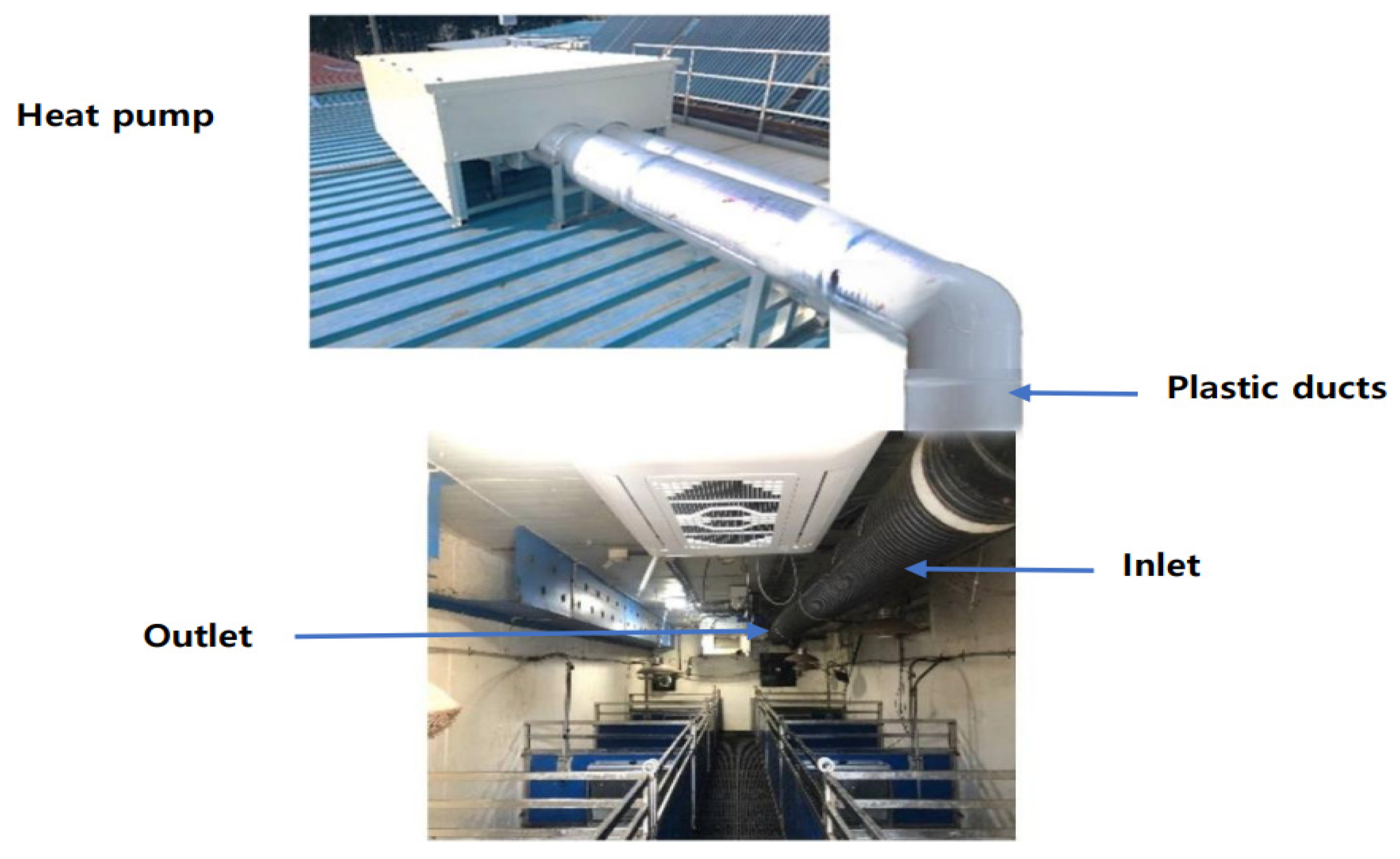
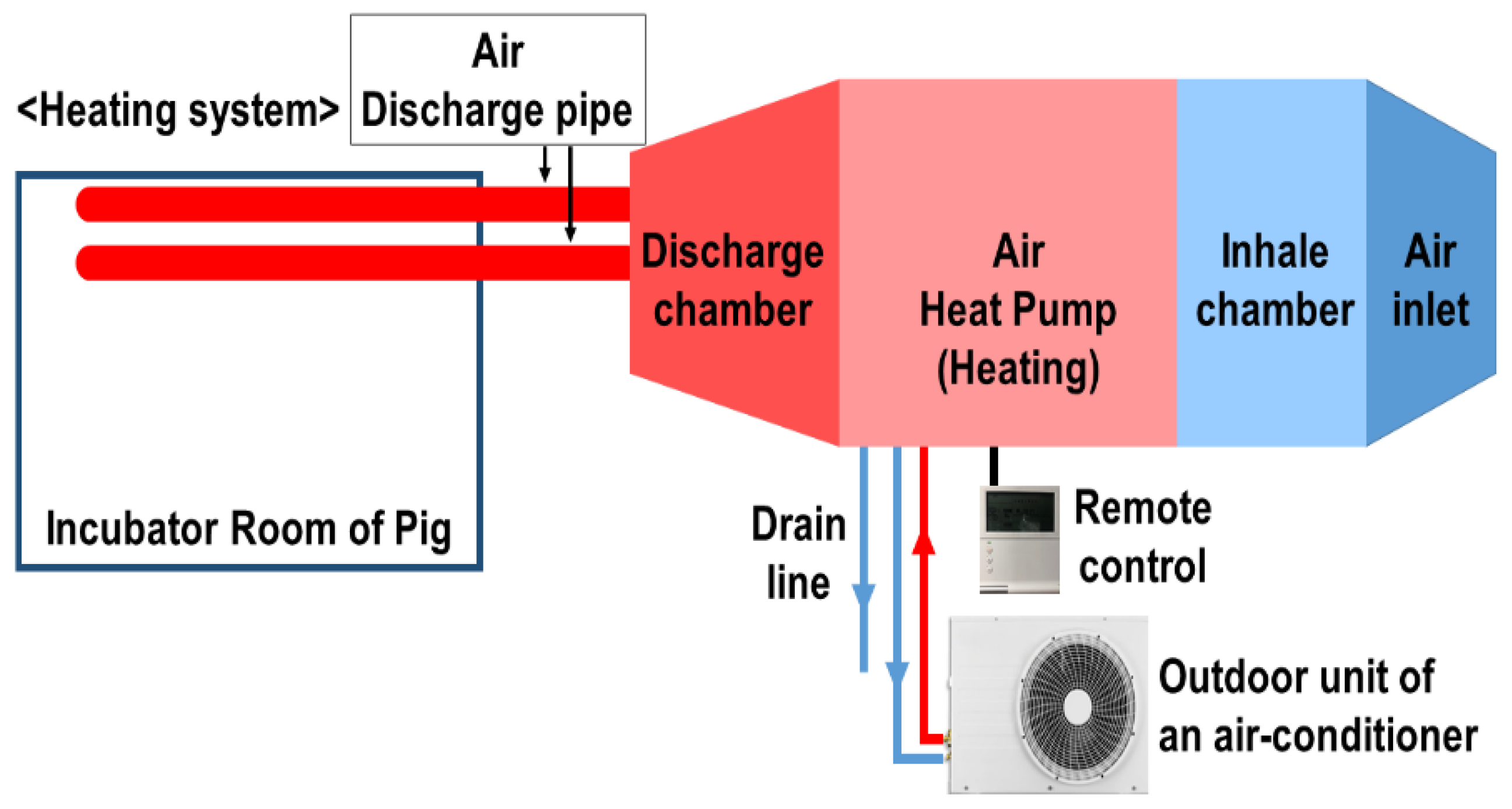
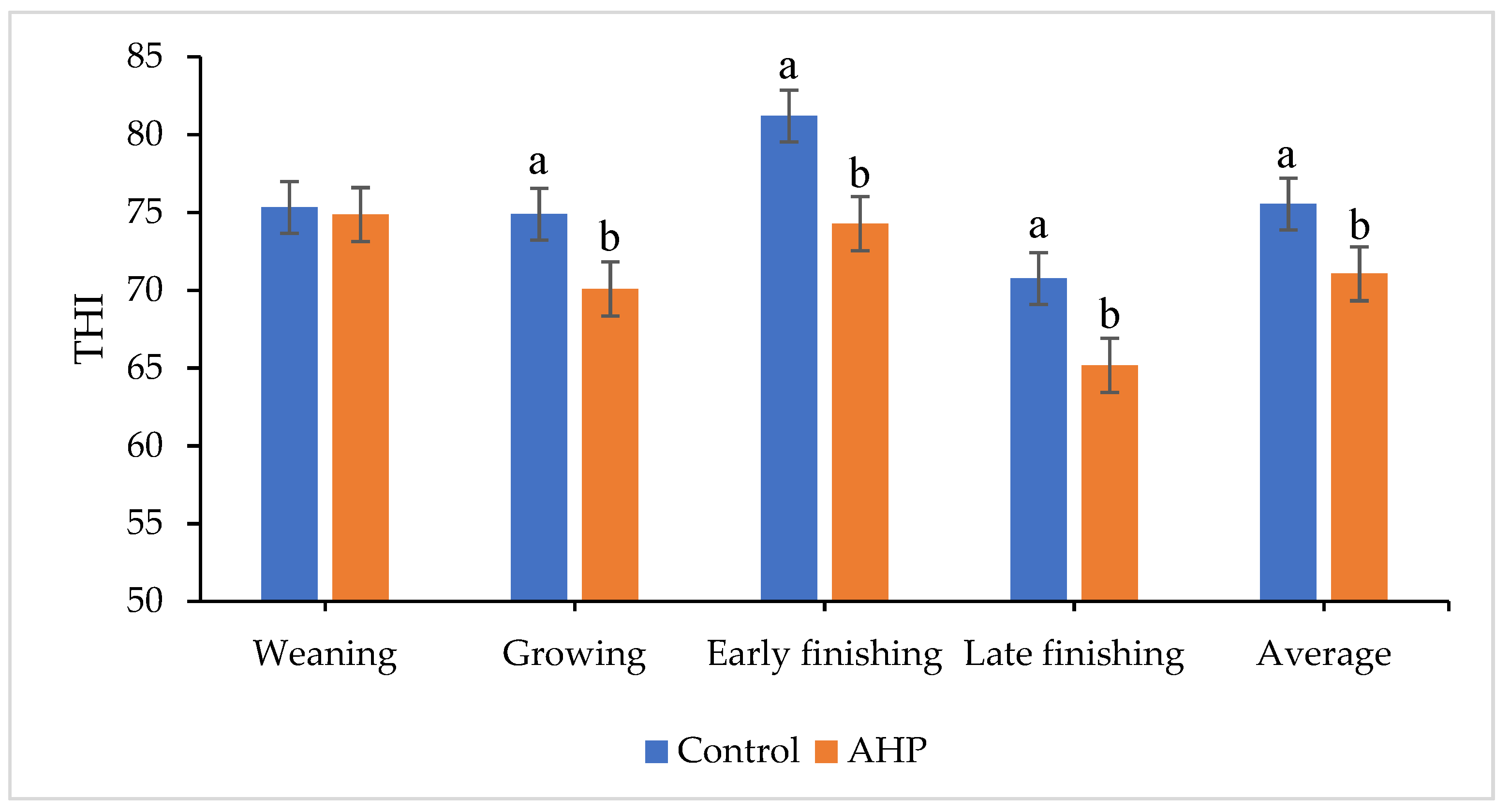
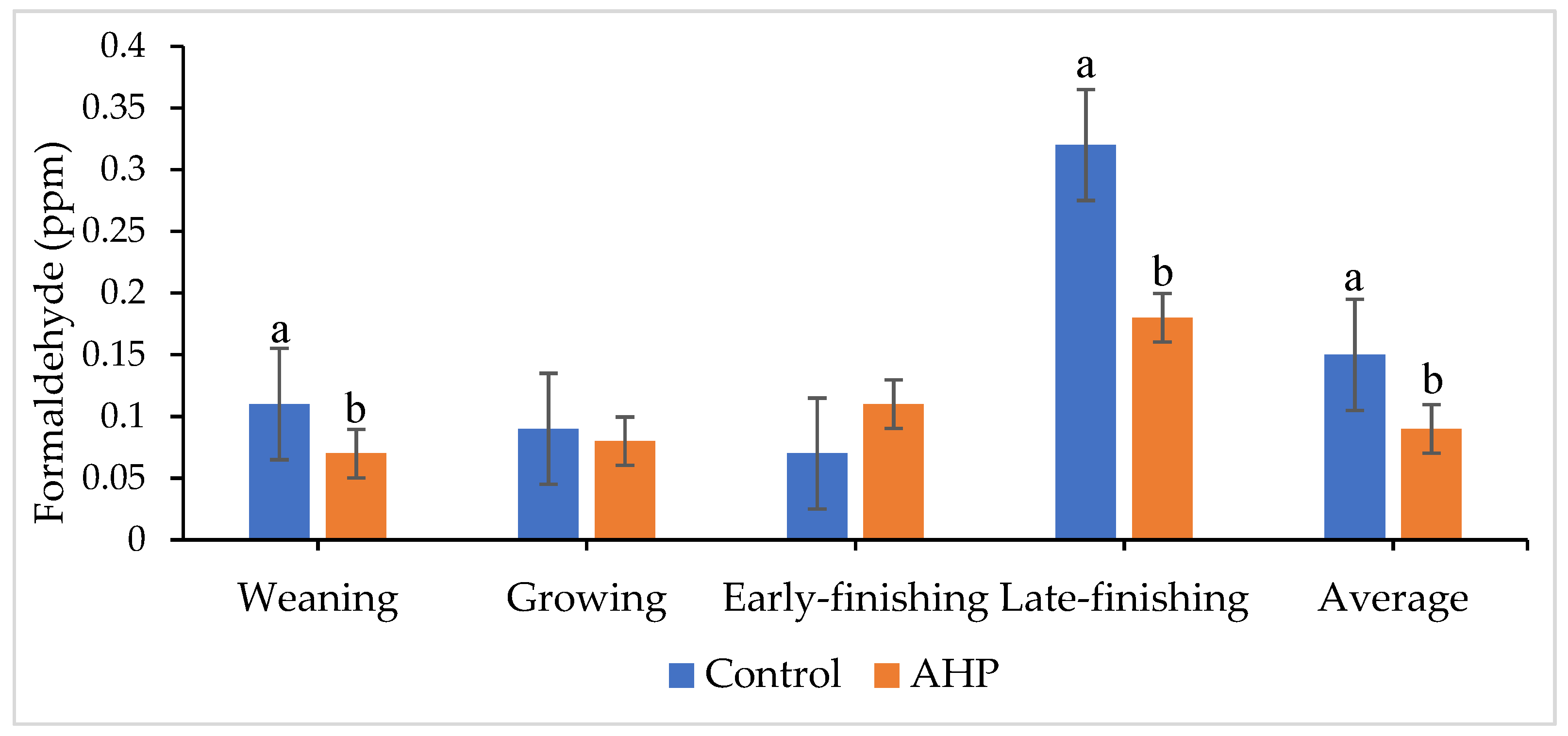
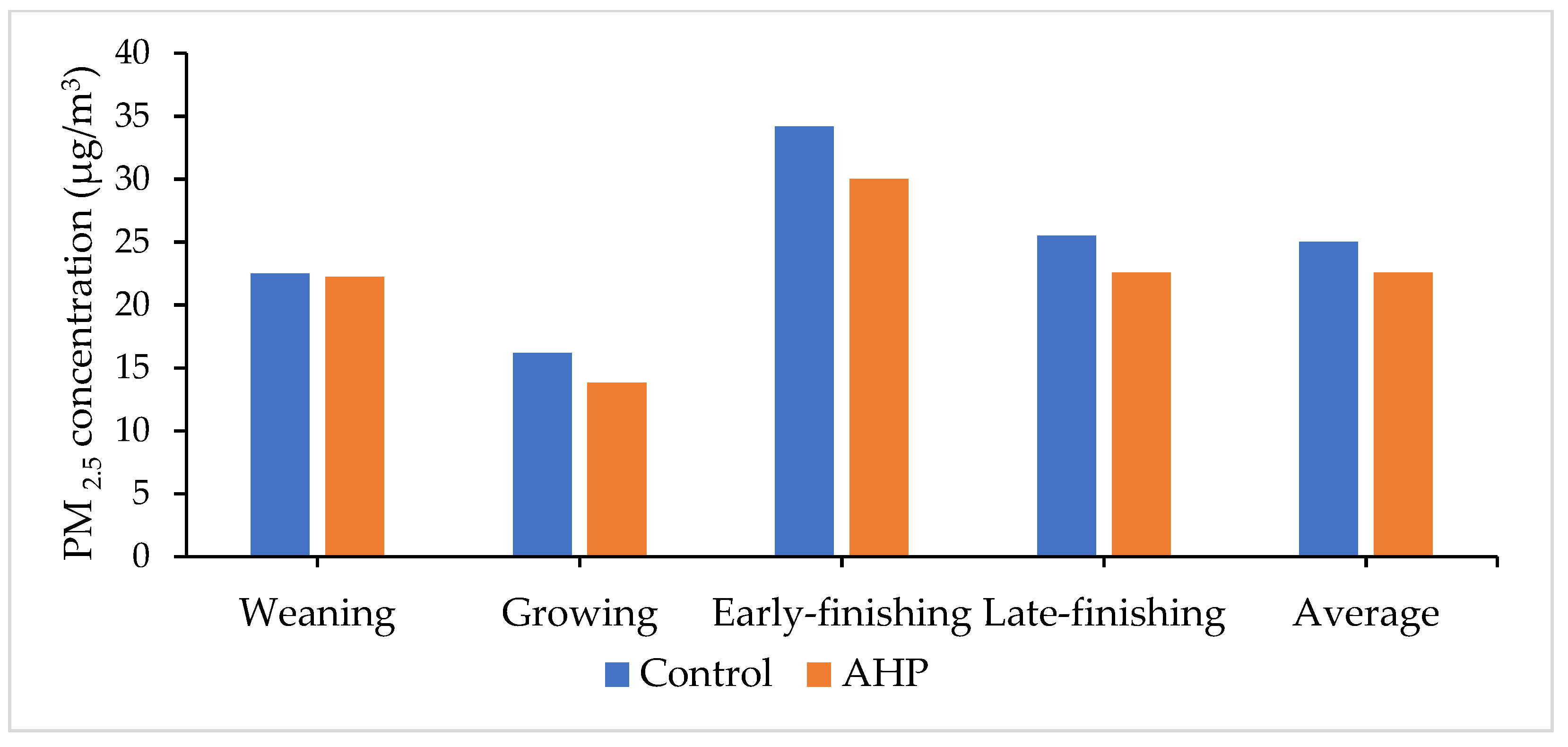
| Parameters | Control | AHP | SEM | p-Value |
|---|---|---|---|---|
| Weaning Period (0–5 weeks) | ||||
| Initial body weight (kg) | 6.18 | 6.16 | 0.37 | 0.9712 |
| Final body weight (kg) | 23.74 | 25.13 | 1.03 | 0.3902 |
| Weight gain (kg) | 17.56 | 18.97 | 0.93 | 0.3311 |
| Feed intake (kg) | 26.6 | 29.18 | 1.19 | 0.1708 |
| FCR | 1.52 | 1.55 | 0.06 | 0.6803 |
| Growing period (6–9 weeks) | ||||
| Initial body weight (kg) | 23.74 | 25.13 | 1.03 | 0.3871 |
| Final body weight (kg) | 48.53 | 50.08 | 2.21 | 0.6432 |
| Weight gain (kg) | 24.79 | 24.95 | 1.20 | 0.8921 |
| Feed intake (kg) | 67.68 a | 54.62 b | 2.81 | 0.0085 |
| FCR | 2.78 | 2.94 | 0.15 | 0.4781 |
| Early-finishing period (10–14 weeks) | ||||
| Initial body weight (kg) | 48.53 | 50.08 | 2.21 | 0.6422 |
| Final body weight (kg) | 75.61 | 78.80 | 2.90 | 0.4793 |
| Weight gain (kg) | 27.09 | 28.72 | 1.30 | 0.0931 |
| Feed intake (kg) | 81.29 | 86.26 | 3.02 | 0.2611 |
| FCR | 3.84 | 3.50 | 0.16 | 0.1721 |
| Late-finishing (5–19 weeks) | ||||
| Initial body weight (kg) | 75.61 | 78.80 | 2.90 | 0.4791 |
| Final body weight (kg) | 108.47 | 113.38 | 3.64 | 0.3692 |
| Weight gain (kg) | 32.86 | 34.58 | 0.65 | 0.4234 |
| Feed intake (kg) | 101.16 b | 113.24 a | 3.91 | 0.0436 |
| FCR | 4.04 | 4.33 | 0.17 | 0.2411 |
| Average (0–19 weeks) | ||||
| Initial body weight (kg) | 6.18 | 6.16 | 0.37 | 0.9701 |
| Final body weight (kg) | 108.47 | 113.38 | 3.65 | 0.3693 |
| Weight gain (kg) | 102.29 | 107.22 | 3.55 | 0.3565 |
| Feed intake (kg) | 276.74 | 283.30 | 8.58 | 0.5991 |
| FCR | 2.55 | 2.64 | 0.05 | 0.2876 |
| Growth Phase | Outside | Control | AHP | SEM | p-Value | Average COP |
|---|---|---|---|---|---|---|
| Weaning | 28.70 | 25.85 a | 25.01 b | 0.21 | 0.0055 | 4.10 |
| Growing | 27.31 | 24.31 a | 21.12 b | 0.21 | <0.0001 | 3.90 |
| Early-finishing | 31.12 | 27.76 a | 23.44 b | 0.15 | <0.0001 | 3.98 |
| Late-finishing | 26.49 | 22.15 a | 18.60 b | 0.17 | <0.0001 | 3.95 |
| Average | 28.40 | 25.03 a | 22.02 b | 0.22 | <0.0001 | 3.89 |
| Growth Phase | Control | AHP | SEM | p-value |
|---|---|---|---|---|
| Ammonia (NH3 ppm) | ||||
| Weaning | 2.54 a | 2.25 b | 0.09 | 0.0190 |
| Growing | 1.50 | 1.34 | 0.06 | 0.0710 |
| Early-finishing | 1.46 a | 1.18 b | 0.09 | 0.0470 |
| Late-finishing | 1.27 b | 1.69 a | 0.06 | 0.0001 |
| Average | 1.71 | 1.63 | 0.05 | 0.3500 |
| Hydrogen sulfide (H2S ppm) | ||||
| Weaning | 0.01 a | 0.00 b | 0.02 | 0.0002 |
| Growing | 0.01 a | 0.00 b | 0.01 | 0.0318 |
| Early-finishing | 0.01 | 0.01 | 0.01 | 0.4147 |
| Late-finishing | 0.02 a | 0.00 b | 0.01 | 0.0318 |
| Average | 0.01 a | 0.00 b | 0.02 | 0.0201 |
| Total volatile organic compounds (TVOC ppm) | ||||
| Weaning | 0.14 | 0.12 | 0.11 | 0.0170 |
| Growing | 0.18 a | 0.13 b | 0.17 | 0.0047 |
| Early-finishing | 0.13 | 0.12 | 0.08 | 0.2500 |
| Late-finishing | 0.14 | 0.11 | 0.04 | 0.1610 |
| Average | 0.15 | 0.12 | 0.10 | 0.1781 |
| Growth Phase (Weeks) | Energy Consumption (kWh) | CO2 Emission (kg) | ||
|---|---|---|---|---|
| Control | AHP | Control | AHP | |
| Weaning | ||||
| 1st week | 214.75 | 134.70 | 103.72 | 65.06 |
| 2nd week | 117.10 | 69.90 | 56.56 | 33.76 |
| 3rd week | 112.70 | 103.05 | 54.43 | 49.77 |
| 4th week | 62.30 | 92.60 | 30.09 | 44.73 |
| 5th week | 61.65 | 80.48 | 29.78 | 38.87 |
| Average | 113.70 | 96.15 | 54.92 | 46.44 |
| Growing | ||||
| 1st week | 46.60 | 41.25 | 22.51 | 19.92 |
| 2nd week | 49.30 | 36.30 | 23.81 | 17.53 |
| 3rd week | 60.05 | 57.25 | 29.00 | 27.65 |
| 4th week | 63.60 | 71.20 | 30.72 | 34.39 |
| Average | 54.89 | 51.50 | 26.51 | 24.87 |
| Finishing | ||||
| 1st week | 60.70 | 49.45 | 29.32 | 23.88 |
| 2nd week | 61.30 | 45.60 | 29.61 | 22.02 |
| 3rd week | 52.60 | 55.10 | 25.41 | 26.61 |
| 4th week | 77.90 | 66.93 | 37.63 | 32.32 |
| 5th week | 25.80 | 29.95 | 12.46 | 14.47 |
| Average | 55.66 | 49.41 | 26.88 | 23.86 |
| Total | 1066.35 | 933.75 | 515.05 | 451.00 |
Publisher’s Note: MDPI stays neutral with regard to jurisdictional claims in published maps and institutional affiliations. |
© 2021 by the authors. Licensee MDPI, Basel, Switzerland. This article is an open access article distributed under the terms and conditions of the Creative Commons Attribution (CC BY) license (https://creativecommons.org/licenses/by/4.0/).
Share and Cite
Rathnayake, D.; Mun, H.-S.; Dilawar, M.A.; Chung, I.-B.; Park, K.-W.; Lee, S.-R.; Yang, C.-J. Effect of Air Heat Pump Cooling System as a Greener Energy Source on the Air Quality, Housing Environment and Growth Performance in Pig House. Atmosphere 2021, 12, 1474. https://doi.org/10.3390/atmos12111474
Rathnayake D, Mun H-S, Dilawar MA, Chung I-B, Park K-W, Lee S-R, Yang C-J. Effect of Air Heat Pump Cooling System as a Greener Energy Source on the Air Quality, Housing Environment and Growth Performance in Pig House. Atmosphere. 2021; 12(11):1474. https://doi.org/10.3390/atmos12111474
Chicago/Turabian StyleRathnayake, Dhanushka, Hong-Seok Mun, Muhammad Ammar Dilawar, Il-Byung Chung, Kwang-Woo Park, Sang-Ro Lee, and Chul-Ju Yang. 2021. "Effect of Air Heat Pump Cooling System as a Greener Energy Source on the Air Quality, Housing Environment and Growth Performance in Pig House" Atmosphere 12, no. 11: 1474. https://doi.org/10.3390/atmos12111474
APA StyleRathnayake, D., Mun, H.-S., Dilawar, M. A., Chung, I.-B., Park, K.-W., Lee, S.-R., & Yang, C.-J. (2021). Effect of Air Heat Pump Cooling System as a Greener Energy Source on the Air Quality, Housing Environment and Growth Performance in Pig House. Atmosphere, 12(11), 1474. https://doi.org/10.3390/atmos12111474








